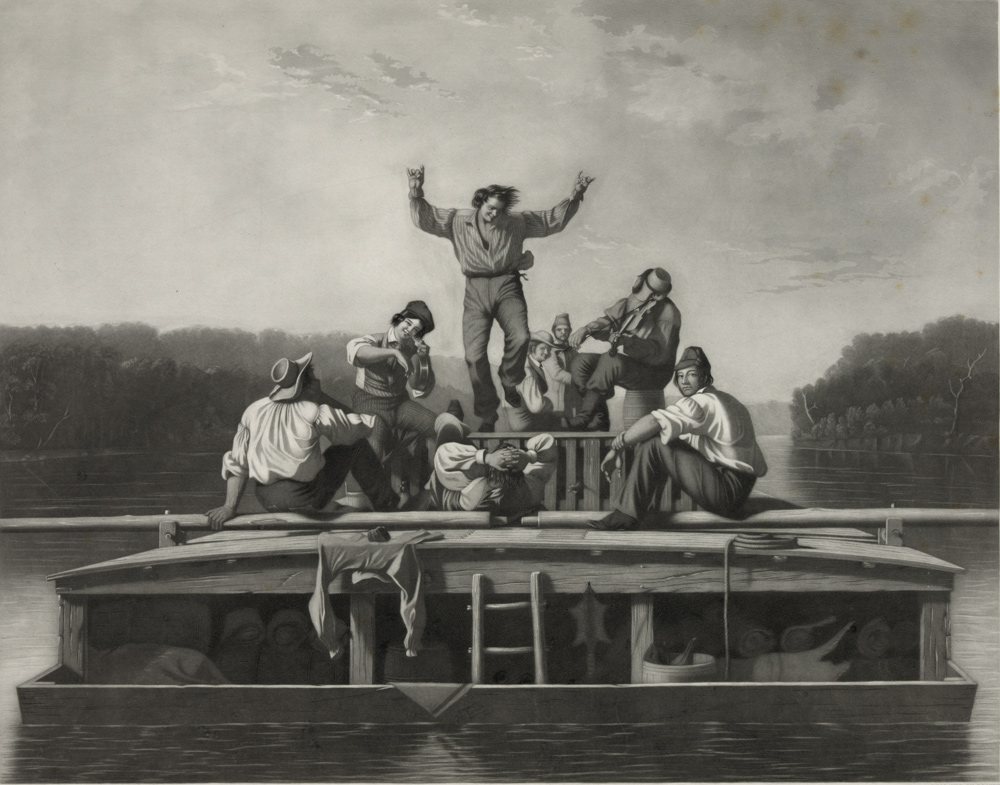Pittsburgh, PA Lewis is preparing for departure down the Ohio River. Here, Ohio river boatmen are described by François André Michaux and Timothy Flint.
The Jolly Flat Boat Men (1847)
by George Caleb Bingham (1811-1879)
Thomas Doney, engraver; printed by Powell & Co. Provided by Library of Congress, 96516487.
Ohio River Bargemen
The bargemen return thus by sea to Philadelphia or Baltimore, whence they go by land to Pittsburgh and the environs, where the major part of them generally reside. Although the passage from New Orleans to one of these two ports is twenty or thirty days, and that they have to take a route by land of three hundred miles to return to Pittsburgh, they prefer this way, being not so difficult as the return by land from New Orleans to Pittsburgh, this last distance being fourteen or fifteen hundred miles. However, when the barges are only destined for Limeston, in Kentucky, or for Cincinnati, in the state of Ohio, the bargemen return by land, and by that means take a route of four or five hundred miles.
—François André Michaux[1]Travels to the West of the Alleghany Mountains (1805 reprint from London edition), p. 62 in Reuben G. Thwaites, Travels West of the Alleghanies (Cleveland: The Arthur H. Clark Co., 1904), p. 159.
Ohio River Boatmen
Missionary Timothy Flint and his family initially started down the Ohio in a Kentucky flatboat, but after a harrowing ride through “Dead Man’s Riffle,” the family decided to buy their own skiff. The Ohio River boat crews left quite an impression on the devout Flint:
The manners of the boatmen are as strange as their language. Their peculiar way of life has given origin not only to an appropriate dialect, but to new modes of enjoyment, riot, and fighting. Almost every boat, while it lies in the harbour has one or more fiddles scraping continually aboard, to which you often see the boatmen dancing. There is no wonder that the way of life which the boatmen lead, in turn extremely indolent, and extremely laborious; for days together requiring little or no effort, and attended with no danger, and then on a sudden, laborious and hazardous, beyond Atlantic navigation; generally plentiful as it respects food, and always so as it regards whiskey, should always have seductions that prove irresistible to the young people that live near the banks of the river. The boats float by their dwellings on beautiful spring mornings, when the verdant forest, the mild and delicious Temperature of the air, the delightful azure of the sky of this country, the fine bottom on the one hand, and the romantic bluff on the other, the broad and smooth stream rolling calmly down the forest, and floating the boat gently forward,—all these circumstances harmonize in the excited youthful imagination. The boatmen are dancing to the violin on the deck of their boat. They scatter their wit among the girls on the shore who come down to the water’s edge to see the pageant pass. The boat glides on until it disappears behind a point of wood. At this moment perhaps, the bugle, with which all the boats are provided, strikes up its note in the distance over the water. These scenes, and these notes, echoing from the bluffs of the beautiful Ohio, have a charm for the imagination, which, although I have heard a thousand times repeated, and at all hours, and in all positions, is even to me always new, and always delightful.
—Timothy Flint[2]Timothy Flint, Recollections of the Last Ten Years, Passed in Occasional Residences and Journeyings in the Valley the Mississippi, from Pittsburg and the Missouri to the Gulf of Mexico, from Florida … Continue reading
Notes
| ↑1 | Travels to the West of the Alleghany Mountains (1805 reprint from London edition), p. 62 in Reuben G. Thwaites, Travels West of the Alleghanies (Cleveland: The Arthur H. Clark Co., 1904), p. 159. |
|---|---|
| ↑2 | Timothy Flint, Recollections of the Last Ten Years, Passed in Occasional Residences and Journeyings in the Valley the Mississippi, from Pittsburg and the Missouri to the Gulf of Mexico, from Florida to the Spanish Frontier. . . (Boston: Cummings, Hilliard, and Company, 1826), 15–16. |
| ↑3 | John Ervin Kirkpatrick, Timothy Flint: Pioneer, Missionary, Author, Editor, 1780–1840 (Cleveland: The Arthur H. Clark Company, 1911), 56, 61–62. |

